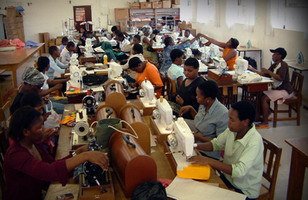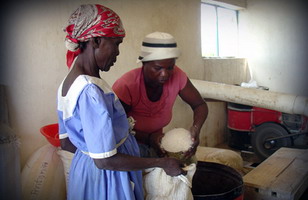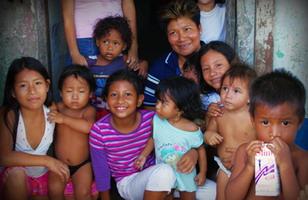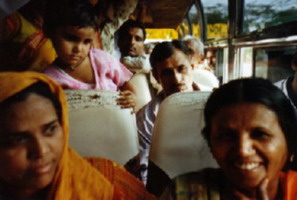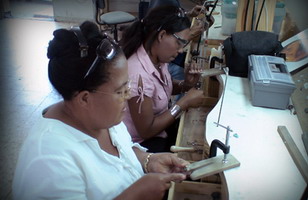
Best Practice in Women's Development
|
|
Phil Barber |
Introduction
In their multiple roles as mothers, daughters, wives and sisters, women and girls often find themselves stretched and overlooked as they seek to improve their own lives and the lives of those around them. In the wake of the international financial crisis and a series of food crises, the pressure on women and girls is higher than ever.
|
The recent successes that many developing nations have had in accessing export markets is being reversed. Many women who found safe, regular employment in factories face redundancy, while migrant workers – the majority of whom are women – also face an uncertain future. Public works and infrastructure programs have been organized as stimuli in the wake of the financial crisis, yet these tend to favor men. Non-essential public services favoring women face cutbacks, and all the while, women are being driven back into part-time, informal employment.
Women and girls are likely to lose out where food crises occur, too. Women's labor dominates agriculture in many parts of the world, and stands to lose the most from falls in production, while climate change is likely to exacerbate issues of agricultural production and pose challenges to women working in the sector. Meanwhile, girls are far more likely than boys to be pulled out of school to help in the field, which damages their future prospects.
Yet these crises and other, more longstanding issues have at least focused greater attention on gender in development, and driven the international development community to seek a wide range of solutions to the problems faced by women and girls. Here are some examples of measures – some local and practical; some general and policy-driven – that would contribute toward the advancement of women and girls.
Water storage and pumping facilities
Placing a water storage or pumping facility in a rural community is most obviously associated with the broad goal of providing clean, potable water, which is a specific target of one of the MDGs. Water storage and pumping facilities also provide a means of irrigating crops, which generates further benefits for communities.
Moreover, women and girls in developing countries are more likely to be responsible for collecting water if the river, well or pump is a long way from a village. In addition to the safety, security and health issues associated with trekking to a distant water source and regularly carrying heavy loads, the process is time-consuming, and prevents women and girls from engaging in otherwise productive activities, including regularly attending school.
The multiplier effects of providing rural communities with greater access to local water resources would be significant, not least by providing more opportunities for women and girls.
Agricultural development
|
Women in rural areas account for more than half the world's food output, and 60 to 80 percent of food output in the developing world, on average. The share of women employed in non-agricultural sectors is particularly low in Africa and Southeast Asia. By creating more job opportunities in the agricultural sector, you'll most likely be employing more women.
But this is not the full picture. During testimony at a TaiwanICDF workshop on gender development in 2009, Bintou Gassama of the Gambian Women's Bureau remarked that agricultural labor “is mostly physically intensive due to lack of labor-saving devices and/or appropriate technologies for production, preservation and marketing.” Investing in agricultural equipment and building capacity in the sector ultimately increases women's opportunities elsewhere. Ensuring that rural communities have the tools to do the job efficiently will also ensure that young girls are not removed from school to help out in the field.
Toilets in schools
The gap between girls and boys enrolling in primary education has been steadily closing over the past decade; yet in secondary education, the gap is narrowing less quickly.
Evidence suggests that one of the factors influencing enrollment could be a lack of clean, private and segregated toilet facilities for girls. As girls grow older, sanitation and privacy becomes increasingly important, to the extent that girls may simply drop out of school, or fail to enroll altogether, if their local school is not up to standard. By ensuring that schools have proper facilities available, girls would have one reason – among many other persuasive motives – to stay in school and complete their education.
Change attitudes
In almost every country in the world, women's rights are protected under the UN Convention on the Elimination of All Forms of Discrimination against Women (CEDAW). Despite enjoying de jure equality, women in many parts of the world still face de facto discrimination as they go about their daily lives.
CEDAW states “that a change in the traditional role of men as well as the role of women in society and in the family is needed to achieve full equality of men and women,” but it is not enough for governments to legislate for equality for women if men continue to block their progression.
In schools, gender-biased textbooks continue to perpetuate stereotypes that distort children's views of society. In tertiary education and in vocational schools, young women are discouraged from enrolling for study in science and engineering subjects. In the home, women are statistically more likely – and in many cultures, expected – to contribute toward unpaid, household work. And at the highest level, even in developed countries, women are underrepresented in political life.
National governments need to develop gender-neutral, non-discriminatory national development strategies that work in practice, as well as in principle. Particularly, men should be encouraged to play a greater part alleviating the burdens in life that have traditionally been foisted upon women. It should fall on the international development community to encourage governments' ownership of this issue, and provide support when and where necessary.
Maternal mortality and access to reproductive health
The UN's latest Millennium Development Goals Report indicates that there is a very significant gap between the reality and the ambition for rates of maternal mortality, particularly in Africa and Southeast Asia. Progress toward achieving this target would be accelerated specifically by mitigating complications arising during labor, some of which may be due to readily preventable illnesses and alleviated by an increased availability of emergency care during labor.
Similarly, the same report notes that fewer than half of pregnant women in developing countries have the benefit of adequate prenatal care. Access to reproductive health resources would have a positive impact on rates of maternal mortality via a range of interrelated measures such as screening for illnesses that would complicate childbirth, access to emergency services during labor, and expert advise on warning signs to look out for in the event that a birth takes place unattended.
Improving access to reproductive health and general education about reproductive health is also associated with a drop in fertility rates. This reduces the childcare burden and unpaid household work, generating opportunities for women to work or pursue further education.
Childcare
|
Like many household responsibilities, childcare falls primarily on mothers rather than fathers. This burden may be increased for single mothers or for mothers in developing countries, where family size is often greater. If you have to look after a child full-time, it is practically impossible to work full-time. At most, you might be able to work part-time, as do a much higher proportion of women than men. This problem is even more challenging for single mothers.
This benefits of proper childcare are borne out in the available research. A study first published by the Food and Agriculture Organisation of the United Nations (FAO), for example, demonstrated that women in Guatemala City who could rely on a well-organized, subsidized childcare system were far more likely to be in salaried work and receiving relatively higher pay.
HIV/AIDS
The problem is not just about mothers supporting their own children. Most unpaid care work falls on women. In Africa, this has had a significant impact due to the HIV/AIDS pandemic and its associated care responsibilities.
HIV/AIDS is not only a medical issue; it is also a significant social issue. In its latest World Survey on the Role of Women in Development, the UN observes that “care responsibilities resulting from the HIV/AIDS pandemic fall largely on women and girls.”
In addition to burdening women with the lion's share of caregiving responsibilities for close relatives, the pandemic creates orphans. Women then find themselves having to support an extended family. Parentless children, and particularly girls, are far less likely to receive a full and proper education.
By focusing on reducing the spread of HIV/AIDS by investing in medical and educational resources, the burden on women and girls in affected communities will also decrease.
Conditional cash transfers
Conditional cash transfer (CCT) programs usually involve the redistribution of cash or equivalent goods to a specific, disadvantaged group, contingent upon certain conditions being met.
Programs such as the Food-for-Education (FFE) program in Bangladesh aim to provide an incentive for participants' continued participation in education. Children in less developed countries, especially girls, are often forced to drop out of school in order to attend to agricultural activities that support their family. Parents consider this to be the lesser of two evils, since the immediate, short-term implications of failing to supply their family with adequate sustenance appear greater than the long-term loss of education.
Through the FFE program, affiliated schools offered a child's family a set amount of grain on condition that the child attended at least 85 percent of classes. Over a two-year period before and after the introduction of the FFE program, primary enrollment increased by 44 percent for girls and 28 percent for boys; moreover, the drop-out rate was lower for children receiving these benefits.
In a similar vein, CCT programs could also be used to subsidize qualified, state-approved child care programs in return for a mother taking on full-time work.
Transportation
|
Walking to school or work in the early morning or late at night is not always safe, or at least, it is not always perceived as being safe. By investing in private minibuses or subsidizing public transport, schools, training institutions or companies would not only guarantee safety for women and girls, but would also communicate a positive message within the community: “We want you to come and study or work with us, and we will help you to do it.”
Microfinance
Access to cash is not a “magic bullet” that transforms lives instantaneously. Women in microfinance continue to face gender-related constraints, and accordingly, a number of adjustments to policy and practice have been proposed to maximize the utility of resources they receive.
Firstly, since women have historically had less access to education, microfinance schemes must offer increasing supplementary support through services such as financial literacy courses and legal advice.
Secondly, microfinance services offering home visits to rural areas are more convenient and increase the likelihood of women engaging in the practice, and making timely repayments.
Thirdly, an ongoing reduction in the role of microfinance as “social welfare” and the corresponding push for the “commercialization” of the sector is likely to alienate women. The UN's latest World Survey on the Role of Women in Development states that women are “far more likely” to engage in microfinance if they can do so as part of a group. Yet microfinance organizations are increasingly offering higher value loans to individual borrowers. This excludes a greater number of women, despite their greater likelihood of making loan repayments on time and offering less risk.
For these reasons, microfinance organizations endeavoring to offer services of a broadly “social” nature should continue to be supported – and, where social benefits can be proven, subsidized – by the international development community. Continuing to support microfinance as a kind of “social welfare” for women may, in fact, prove to be a more successful and sustainable financial strategy.
Access to adult continuing education
go some way toward redressing the balance between older women and the rest of society. |
Older women are competing against males of the same age who have historically received much higher levels of education, and against young people, both male and female, who have enjoyed the fruits of an MDG-driven movement for equality in education.
A lack of education, including qualifications, and particularly basic reading and writing abilities, will affect older women's opportunities to a greater degree, given employers' general unwillingness to take on older persons, and particularly any with child care commitments.
Encouraging adult continuing education would go some way toward redressing this balance. This could include a wide range of actions such as greater access to libraries or internet services in rural communities, policy changes to encourage a greater intake of mature students at universities, including those with non-standard educational backgrounds and qualifications; part-time and evening access to educational courses, and access to a wider range of materials and remedial courses in both rural and urban community centers.
Action against domestic violence, abuse and trafficking
The vast majority of countries have ratified CEDAW, yet laws relating to domestic violence, abuse and trafficking have proven difficult to enforce. Societies often overlook violence against women, stereotype women's roles and lower their expectations toward quality of life and human rights. This way of thinking is often deeply rooted in the policies of government and public institutions. Due to a lack of integration between government departments, investigating and prosecuting the perpetrators of violence is difficult and expensive; meanwhile, national borders are often “porous” and practically impossible to patrol effectively.
Governments should encourage communication between departments involved in these issues. The use of information and communications technology to share information through integrated databases might aid investigation, improve efficiency and lead to an increased conviction rate.
Training can also help officials, social workers and community advocates to spot subtle danger signs of abuse, and mass awareness programs ensure that women know their rights with respect to domestic laws and emigrants' rights. Support programs can also offer medical and psychological support to victims of domestic violence, provide legal support or advice, and shelter victims of these type of abuses.
Finally, multilateral efforts are required to guarantee the protection of migrant workers' rights, and ensure that emigrants – the majority of whom are women – are not exploited or abused as they go about seeking a better life.
- 更新日期: 2022/05/19
- 點閱次數:709

